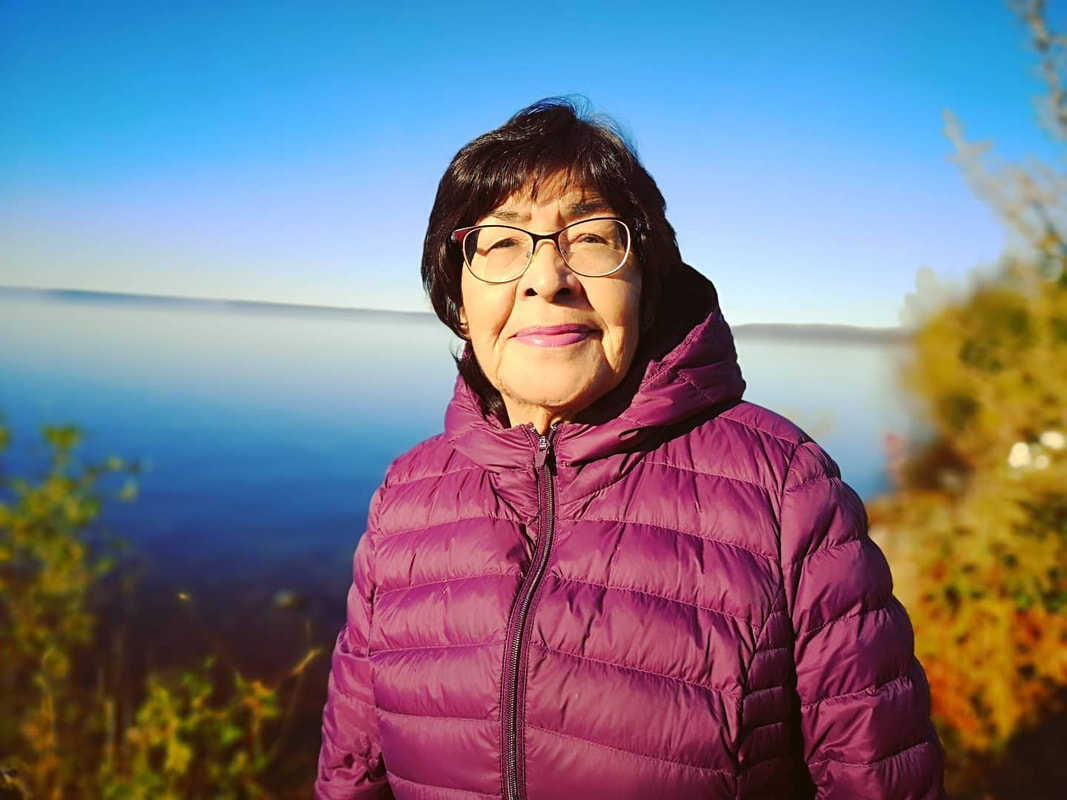|
This is part of a series of profiles about the staff, leaders, and community members who are hard at work implementing Łutsël K’é Dene First Nation's vision for the Thaidene Nëné Indigenous Protected Area. You can read the other profiles here.  Addie Jonasson was born Adeline Boucher in a tent on Tędhul Dezé (Snowdrift River) in the fall time. For the first eight years of her life, she lived on the land with her parents, Joe Boucher and Judith Rose Laloche, and her siblings, Albert, Ernest, Fred, John, and Samuel. In the winter, the family stayed at Snowdrift. In the summer, though, they would travel around the lake. “The deep connection that I have to the land,” Addie explains, “is because my parents taught me their traditions. They passed along the knowledge.” Addie’s first language is Dënesųłıné yatı. It was only when she was taken to residential school at eight years old that she learned to speak English. Though they weren’t allowed to speak their Indigenous languages while at school, Addie recalls finding ways to speak the language with the other kids from her community. “Most of us that went to school in the 1950s and 1960s kept our language,” she says. Addie attended residential school for 12 years, first in Fort Resolution, then in Fort Smith, before eventually graduating from Akaitcho Hall in Yellowknife. Addie married soon after finishing high school and left the North when her husband, Jerry, who was an aircraft engineer, was offered a job in Ontario. For the next 22 years, the Jonassons lived in Ontario, Manitoba, and Alberta. While Jerry worked on planes, Addie pursued a career in social work. The couple also raised two children: Laurice and Jennifer. In 1992, there was an opening in Łutsël K’é for a community social services worker. “I wanted to come back,” Addie remembers. “I missed home. I missed my roots. I especially missed the lake, the water, the space.” Addie, Jerry, and their children packed their bags and moved north. In addition to her work in social services, Addie has served her community as an elected official. She was chief of the Łutsël K’é Dene First Nation from 2006-2008 and a councillor from 2004-2006 and 2014-2020. It was while she was chief that Łutsël K’é signed a memorandum of understanding with the Government of Canada to advance work on creating a national park on the East Arm of Tu Nedhé (Great Slave Lake). Addie has supported Thaidene Nëné in other ways. In 2009, she answered a call for committee members for the Thaidene Nëné Advisory Committee. “The committee helped to make sure that we protected the area, the land, the water, the animals. We wanted to make sure that our way of life wasn’t disrupted, so we would continue to live as we have living since time immemorial.” Most recently, Addie was appointed to Thaidene Nëné Xá Dá Yáłtı, the management board for the Thaidene Nëné Indigenous Protected Area. (Xá Dá Yáłtı means those who speak for Thaidene Nëné in Dënesųłıné.) Along with the other appointees, over the coming months and years, Addie will provide strategic guidance to the parties (LKDFN, Parks Canada, and the GNWT) as they implement Łutsël K’é's vision for Thaidene Nëné. Addie speaks with a quiet passion about the need to protect the land of her ancestors, to ensure that the beautiful, peaceful, and abundant land that has sustained her people for millennia will be there for future generations. In her words, “When I talk about the land, I think about my grandparents who lived out on the land year-round. I want to make sure that our grandkids and great-grandkids have something to rely on, something to sustain them.” Addie has seen first hand what can happen without such protections. In the early 1970s, Addie and her family were living in Sioux Narrows. “One day, we were driving towards Dryden and we passed the Wabagoon River. The river was full of suds. That was pollution from the pulp mills. That memory has stayed with me. I never want to see anything like that happen to our lakes and rivers.” Addie sees Thaidene Nëné as an opportunity to invest in the land in the way that is different. “We’re not investing in a mine,” she says. “We are investing in the beauty of the land.” Creating an Indigenous protected area, which will attract people from across the territory and around the world, Addie believes, will sustain her community and its members in a way that the mines cannot. “Thaidene Nëné,” she notes, “will be here forever.” Addie invites visitors to experience the pristine beauty of her homeland. “Sit down by the shoreline. See the beauty, feel the tranquility. Experience the peace and the quiet. Hear the birds, the ducks. See the muskox, the moose, the bears in there natural habitat.” Do this, Addie says, and you will see why the people of Łutsël K’é are so passionate about Thaidene Nëné. “Our ancestors chose the best place for us. I say thank you to them all the time.” Comments are closed.
|
AuthorWrite something about yourself. No need to be fancy, just an overview. Archives
July 2024
Categories |
CONNECT |
VISIONWe are the Lutsel K’e Dene First Nation. Our vision for Thaidene Nëné is:
Nuwe néné, nuwe ch'anıé yunedhé xa (Our land, our culture for the future). We’re working with our partners to permanently protect Thaidene Nëné—part of our huge and bountiful homeland around and beyond the East Arm of Tu Nedhé. |
